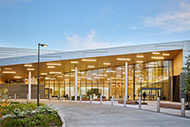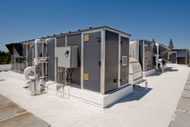Showcasing the best health care building design and design-oriented research, the American Institute of Architects (AIA) has selected seven recipients for its Healthcare Design Awards.
Projects exhibit conceptual strengths that solve aesthetic, civic, urban and social challenges while fulfilling the functional and sustainability concerns of health facilities, according to the AIA.
The seven winners were named in four categories:
- Category A. Built; less than $25 million in construction cost
- Category B. Built; more than $25 million in construction cost
- Category C. Renovations/remodeled; primarily built within existing hospital or clinical space
- Category D. Unbuilt; must be commissioned for compensation by a client with the authority and intention to build
One of the two winners in Category A is Harvey Pediatric Clinic, Rogers, Ark., which was designed by Marlon Blackwell Architects.
The clinic represents an abstract figure set in contrast to the excess of materials, weak forms and beige tones that make up the everyday suburban landscape that surrounds the building, the AIA states.
The cayenne-colored metal panel wraps the entire south side of the building, providing a strong identity for the clinic. Patients enter the building, pass through and ascend a stair that is washed in blue light from a skylight above. Sixteen exam rooms are organized along a simple, clear circulation path defined by several skylights that bring natural light deep into the building.
The second winner in Category A is Neighborcare Health, designed by architectural firm NBBJ, and located in the Meridian Center for Health, Seattle.
The Meridian Center for Health is an integrated, one-stop model for health treatment and prevention for underserved Seattle-area residents. Uniting three health organizations under the same roof, the center provides low- to no-cost medical, dental and mental health services for adults and children.
Design elements include an open floor plan, a dramatic stair in the lobby and a range of team and community spaces that remain available for neighborhood organizations after hours. The facility is tracking to receive LEED Gold certification.
The first of two winners in Category B is Mercy Virtual Care Center, Chesterfield, Mo., and the architect was Forum Studio.
The Virtual Care Center is a first-of-its-kind facility that advances Mercy’s mission of improved outcomes through better patient management while pioneering a new model of care. The four-story hospital without beds houses a variety of telemedicine programs that allow Mercy to care for patients remotely round-the-clock.
The design blends with nature through the use of materials and space, says the AIA. A palette of stone, glass, precast and wood coupled with flexible floor plates create an environment that fosters innovation, collaboration and patient-centric care.
The second winner in Category B is UC San Diego Health–Jacobs Medical Center, La Jolla, Calif. The architect was CannonDesign.
Jacobs Medical Center is designed as three hospitals in one with a focus on women’s and children’s, cancer and specialty surgery. The tower is the cornerstone of a new campus identity focused on the future of health, pairing cutting-edge, modern medicine with best-in-class patient experience.
One of two winners in Category C is Advocate Lutheran General Hospital Cardiac Catheterization Suite, Park Ridge, Ill. The space was designed by Philips Design and Anderson Mikos Architects.
The design team worked closely with key stakeholders to achieve the Advocate Health Care Heart Institute’s goal of improved customer experience, safety and outcomes.
The new cardiac catheterization suite transforms the patient, family and staff experiences. The optimized flow includes a transradial recovery lounge, labs that inspire confidence while improving safety, and a first-of-its-kind prep/recovery bay solution that enables a less stressful recuperation personalized for each patient, AIA states.
The second winner in Category C was Bayshore Dental, Whitefish Bay, Wis., which was designed by Johnsen Schmaling Architects.
The project transformed an abandoned building into a state-of-the-art clinic. A continuous ceiling plane leads patients from the light-filled reception area to the procedural spaces, each marked by green vertical panels and light strips that animate the clinic’s central corridor.
The winner of Category D was Ambulatory Surgical Facility, Kyabirwa, Uganda. The designer was Kliment Halsband Architects.
The facility will include a reception pavilion with offices grouped around a family waiting area courtyard, an intermediate pavilion for pre-op and post-op activities, and a sterile pavilion with two operating rooms and related support spaces.





